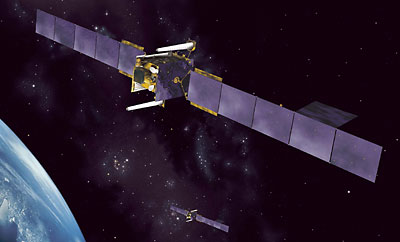Future British military space policyby Taylor Dinerman
|
| The question arises: how does the UK plan to protect its space-based communication system from future attacks? |
Britain’s principal military space assets are the pair of Skynet 4 communications satellites. They will be replaced by the Skynet 5 series that will provide British forces with communication services but will not be owned by them. This kind of program is called a private finance initiative (PFI). The £2.5 billion contract was won by an EADS-led consortium that has committed to launching the first Skynet 5 in 2008. These agreements have become something of a British specialty in the last decade or so. They seem to be an outgrowth of Margaret Thatcher’s successful privatization programs.
It is open to question how effective these non-traditional procurement programs have been. The leasing arrangement for the Boeing C-17 transports is, as far as one can tell, a roaring success. Others may not be the shining examples of effectiveness that the Ministry of Defence would like to present to the world.
The question arises: how does the UK plan to protect its space-based communication system from future attacks? The variety of primitive and asymmetric antisatellite weapons is growing each year. As more and more nations develop the capacity to launch satellites they also, theoretically, have the capacity to attack satellites in low earth orbit (LEO) and, later, in geosynchronous orbit (GEO), where the Skynet 5 satellites will be placed.
Presumably, the contractor has promised to harden these satellites against known electronic warfare attacks such as high- or low-powered jamming. It is conceivable that the satellites will also be protected against electromagnetic pulse (EMP) and against high-powered microwaves. However, even the most hardened satellites are still vulnerable to kinetic energy (KE) attack, or to earth- or space-based lasers.
Even primitive KE weapons will be able to force their targets to maneuver out of the way and thus not expend precious propellant for station keeping. With enough attacks over a few weeks, an enemy could force Skynet’s controllers to expend all their fuel supply, thus rendering the satellite practically useless. Having civilian defense contractor personnel maneuvering spacecraft to avoid enemy weapons is a good example of how the conduct of war is being increasingly privatized.
To counter these kinds of threats, the US has been working on a class of escort satellite that will perform the “defensive counterspace” function. These devices are real space weapons and there is no way that the euphemism masters in the Pentagon, or their counterparts elsewhere, can disguise this fact.
| Could the UK build and deploy its own space weapons? Amazingly, the answer is yes. |
If Britain were to put defensive lasers or other protective devices on its satellites, equivalent to the missile defense systems that the Royal Air Force is installing on its C-17s, these would also be seen as “space weapons.” Britain, like many European states has been quietly wrestling with the issue of space weaponization for years. They have agreed to allow the US radar base in Fylingdales, Yorkshire, to be used as part of the US GMD missile defense system. However, that system does not, so far, include space-based interceptors and, thus, the Blair Government can still claim to have kept its space weapons virginity.
A more interesting possibility is that Britain may be the first or second nation in Europe to equip itself with space strike weapons. The RAF has a requirement for a Future Offensive Air System (FOAS), planned to replace the Tornado GR 4 sometime around 2017. They will need “…a capability to strike with precision and in a timely and controlled manner at fixed, relocatable, and mobile hardened and soft targets, by day and by night, and in all weather conditions.” This sounds similar to the requirements for some concepts that have been floating around Air Force Space Command involving rapid global strike. The Common Aero Vehicle (CAV), or similar systems, might fit Britain’s long range strike requirements better than a new manned fighter-bomber or an unmanned combat air vehicle. Since the CAV is, so far, a suborbital system, it cannot still reasonably be called a space weapon—but it does come awfully close.
Could the UK build and deploy its own space weapons? Amazingly, given the relatively tiny investment that the British government has made in space technology, the answer is yes. SSTL certainly has the capacity to turn its small satellites into KE satellite killers. Britain has plenty of home-grown expertise in IR detection systems. While they have not joined in the wasteful race to build a national satellite launch vehicle they could, with some extra investment from the government, modify the X-Prize class Starchaser rocket into a small launch vehicle.
Britain is, indeed, lucky that its entrepreneurial juices have not entirely dried up. Unlike other European states, whose governments have invested massively in space technology and who are struggling to replicate America’s military space infrastructure, the UK has achieved potential military space independence largely through the efforts of small entrepreneurs, such as SSTL’s CEO, Sir Martin Sweeting, and the Starchaser team. It is said that the British Empire was an inadvertent achievement. In the future, it may be said that Britain’s place in space was gained through a similar accident.
